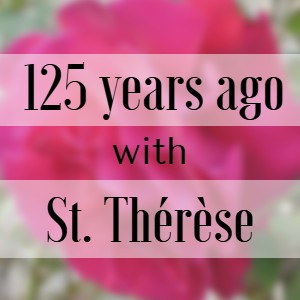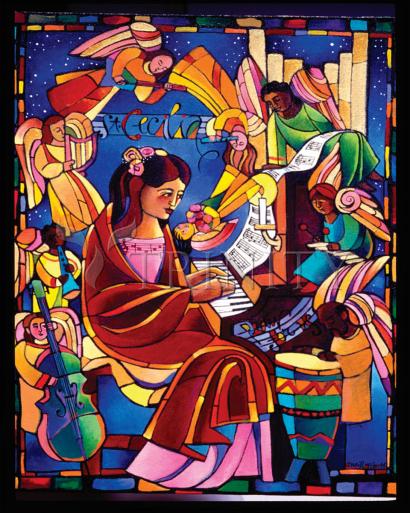125 years ago with St. Therese: "Saint Cecilia," Therese's first long poem, written for Celine's 25th birthday on April 28, 1894
Icon of St. Cecilia, patron of music, by Brother Mickey McGrath, OSFS. Available from Trinity Stores; for information, click on the icon.

For Celine's 25th birthday, April 28, 1894, Therese wrote her third poem, and her first long one. Although it is now titled "Saint Cecilia," (ACL),* the copy she sent to her sister bore the title "The Melody of Saint Cecilia."
Who was St. Cecilia for Therese?
Cecilia was an early Roman martyr. Although many of the stories about her life are legend, her existence and martyrdom are historical facts. Therese tells us in Story of a Soul that her devotion to Cecilia dates from her pilgrimage to Rome in November 1887. When she visited Cecilia's tomb and the site of her house, transformed into a church at her request and learned that Cecilia was named patron of music
"in memory of the virginal song she sang to her heavenly Spouse hidden in the depths of her heart, I felt more than devotion for her; it was the real tenderness of a friend. She became my saint of predilection, my intimate confidante. Everything in her thrilled me, especially her abandonment, her limitless confidence . . .
Story of a Soul: The Autobiography of St. Therese of Lisieux, tr. John Clarke, O.C.D. Washington Province of Discalced Carmelites, 3rd ed., 1996.
Read Therese's full account of her visit to the tomb and church of St. Cecilia on the Web site of the Archives of the Carmel of Lisieux.
Cecilia, a consecrated virgin, was to be married against her will to the pagan Valerian, and, while the instruments sounded to celebrate her nuptials, she went on singing to the Lord in her heart, as the Office for her feast says. This abandonment captured the imagination of the 14-year-old Therese instantly.
Why did Therese write about Saint Cecilia for Celine?
Celine was the Martin sister who stayed longest in "the world." She had managed a household, cared (with the aid of Leonie till 1893) for her sick father, and refused two proposals of marriage. While participating in the active social life of the Guerin family, she had made a private vow of chastity. She would stay with Louis until his death. As the Lisieux Carmel was not likely to accept a fourth nun from the same family, what she would do then was unclear. Faced with the dilemma of Celine's future, Therese explored Cecilia's spiritualitym more deeply. She had proposed the abandonment of Cecilia as a model to her sister in her extraordinarily rich letter of October 1893 for Celine's feast: "the dear little St. Cecilia, what a model for the little lyre of Jesus . . ." (ACL)
Letters of Saint Therese of Lisieux, Vol. II, tr. John Clarke, O.C.D. Washington, D.C.: Washington Province of Discalced Carmelites, 1988, pp. 826-829. Read Therese's full letter on the Web site of the Archives of the Carmel of Lisieux.
Now, having written only two poems, she produces a "symphony" for her sister in "Saint Cecilia" (ACL). The poem's themes, dear to Therese, show the connection between virginity, marriage, and martyrdom. Above all, the poem celebrates Cecilia's abandonment in lines that foreshadow the way of confidence and love Therese will discover soon after Celine enters in September:
You sang this sublime canticle to the Lord:
"Keep my heart pure, Jesus, my tender Spouse!.."
"Ineffable abandonment! Divine melody!
You disclose your love through your celestial song.
Love that fears not, that falls asleep and forgets itself
On the Heart of God, like a little child...
Your chaste union will give birth to soulsWho will seek no other spouse but Jesus.
What happened to the poem later?
During the next three years, Therese shortened and rewrote this poem, sending copies to her spiritual brothers, Adolphe Roulland and Maurice Belliere. Her extensive editorial work shows how important she thought this early poem was. In 1897, she produced a "second edition" with the intention of its being distributed after her death, and this edition is the one ultimately published. Thanks to the generosity of the Washington Province of Discalced Carmelite Friars, you can read the poem online on the incomparable Web site of the Archives of the Carmel of Lisieux. (In this article, the citation ACL indicates that the source is the Web site of the Archives of the Carmel of Lisieux).
For a fuller understanding of Therese's poetry, I recommend the book The Poetry of Saint Therese of Lisieux, tr. Donald Kinney, O,C.D. (Washington, D.C.: Washington Province of Discalced Carmelite Friars, 1996). To grasp the context and the full richness of Therese's poetry, the introductions and notes to each poem in this book, which are not available online, are invaluable.
[Purchasing through the links in this article supports this Web site].


Reader Comments